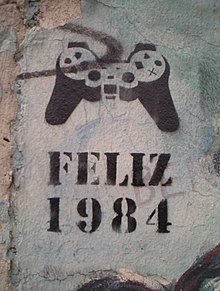| This article includes a list of references, related reading, or external links, but its sources remain unclear because it lacks inline citations. Please help improve this article by introducing more precise citations. (June 2020) (Learn how and when to remove this message) |

Stencil graffiti is a form of graffiti that makes use of stencils made out of paper, cardboard, or other media to create an image or text that is easily reproducible. The desired design is cut out of the selected medium and then the image is transferred to a surface through the use of spray paint or roll-on paint.
The process of stencilling involves applying paint across a stencil to form an image on a surface below. Sometimes multiple layers of stencils are used on the same image to add colors or create the illusion of depth.
Because the stencil stays nearly unchanged throughout its use, it is easier for an artist to replicate what could be a complicated piece - at a high rate when compared to other conventional tagging methods.
History
Stencil graffiti began in the 1960s.
French artist Ernest Pignon-Ernest's stencilled silhouette of a nuclear bomb victim was spray painted in the south of France in 1966 (Plateau d'Albion, Vaucluse)
Dutch artist Hugo Kaagman is one of the key figures of the Amsterdam punk movement. While studying social geography at the city’s municipal university, he became interested in art movements like Dada and Fluxus. He started stencil graffiti in 1978 as part of the punk movement to demonstrate against the Dutch government.
Blek le Rat's first spray painted stencils were seen in Paris in 1981. He was influenced by the graffiti artists of New York City but wanted to create something of his own.



Kraków ul. Podgórska 15.
Australian photographer Rennie Ellis documented some of the earliest examples of stencil art to appear in Sydney and Melbourne in his 1985 book The All New Australian Graffiti. In the introduction to the book, Ellis noted that US photographer Charles Gatewood had written to him and sent him photographs of similar stencil graffiti that had recently appeared in New York City, leading Ellis to speculate that:
... unlike our subway-style graffiti, which is nothing more than a copy of a well-established New York tradition, the symbols of Australia and America had originated separately and unknown to each other.
Over the years this form of graffiti has become a worldwide subculture. The members are linked through the Internet and the images spray-painted on the urban canvas they place throughout the world. Many of its members connect through blogs and websites that are specifically built to display works, get feedback on posted works, and receive news of what is going on in the world of stencil graffiti.
Stencil graffiti is illegal in some jurisdictions, and many of the members of this subculture shroud their identities in aliases. Above / Tavar Zawacki, Banksy, Blek le Rat, Vhils, Shepard Fairey and Jef Aérosol are some names that are synonymous with this subculture.
See also
- Glossary of graffiti
- List of stencil artists
- List of street artists
- Street art sculptures
- Street art
- Street installation
- Wheatpaste street art
- Stencil (typeface)
Further reading
- Manco, Tristan, Stencil Graffiti, Thames and Hudson, 2002. ISBN 978-0500283424
- Smallman, Jake; Nyman, Carl, Stencil Graffiti Capital: Melbourne, West New York, NJ : Mark Batty Publisher, October 1, 2005. ISBN 0-9762245-3-4
Notes
- C215:"Stencil History X". C215, 2007. ISBN 2-9525682-2-7
- Louis Bou: "Street Art". Instituto Monsa de ediciones, S.A., 2005. ISBN 84-96429-11-3
- BTOY: "BTOY:DY:002". Belio Magazine, S.L, 2007. ISBN 84-611-4752-9
- Jinman, Richard, "Street art moves to a posh new hang-out", The Sydney Morning Herald, Sydney, Australia, April 9, 2007.
- Norman, James, "Graffiti goes upmarket", The Age, Melbourne, Australia, August 16, 2003.
- Reiss, Jon, May 3, 2008
- Bello, Manuel, 14 Aug.2007.
- Bello, Manuel
- Rogers, Michelle, "Jef Aerosol", Gadabout Paris, Paris, France, 2008.
- Hugo Kaagman: "Stencil King", 2009, ISBN 9789048802753.
C215 Community Service, Criteres ed. 2011
References
- Ellis, Rennie; The All New Australian Graffiti, Sun Books (Macmillan), Melbourne, 1985 (ISBN 0-7251-0484-8)
| Street art | |
|---|---|
| Culture | |
| Types | |
| Lists of artists | |
| Photographers | |
| Places |
|
| Events | |
| Related | |